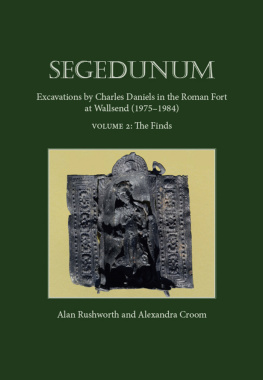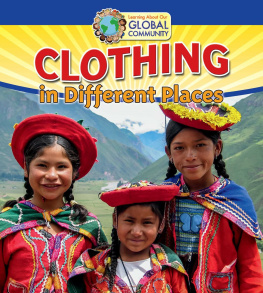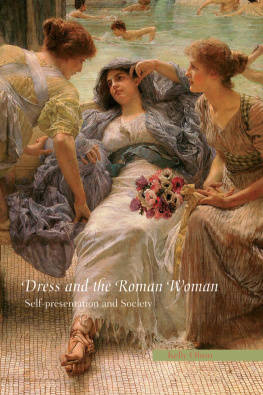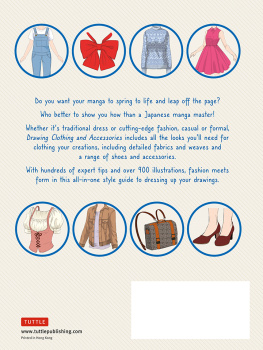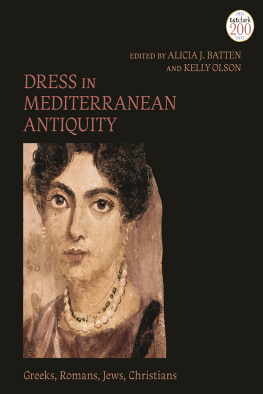ROMAN CLOTHING AND FASHION
ALEXANDRA CROOM
This edition published 2010.
This electronic edition published 2012.
Amberley Publishing
The Hill, Stroud, Gloucestershire GL5 4EP
www.amberley-books.com
Copyright Alexandra Croom 2010, 2012
The right of Alexandra Croom to be identified as the Author of this work has been asserted in accordance with the Copyrights, Designs and Patents Act 1988.
All rights reserved.
No part of this book may be reprinted or reproduced or utilised in any form or by any electronic, mechanical or other means, now known or hereafter invented, including photocopying and recording, or in any information storage or retrieval system, without the permission in writing from the Publishers.
British Library Cataloguing in Publication Data.
A catalogue record for this book is available from the British Library.
ISBN 978-1-84868-977-0 (PRINT)
ISBN 978-1-4456-1244-7 (e-BOOK)
CONTENTS
LIST OF ILLUSTRATIONS
TEXT FIGURES
1 - The costume of goddesses
2 - Woman spinning
3 - Tunic forms
4 - A clothes press
5 - Tunics of the first and second centuries
6 - Tunics of the third and fourth centuries
7 - Tunic decorations
8 - Portrait of Stilicho
9 - Tunics
10 - Togas of the first to fourth centuries
11 - The Brothers sarcophagus
12 - Togas of the fifth and sixth centuries
13 - Short togas
14 - Mantles and cloaks
15 - Cloaks and capes
16 - Tombstone of Ares
17 - Leggings
18 - Puttee
19 - Loincloths
20 - Knitted sock
21 - Footwear
22 - Footwear
23 - Hairstyles of the first to third centuries
24 - Hairstyles of the third to sixth centuries
25 - Headwear
26 - Religious costumes
27 - Amulet
28 - Intaglios and finger-rings
29 - Stola
30 - Tombstone showing woman in a gap-sleeved tunic
31 - Gap-sleeved tunic fastenings
32 - Gap-sleeved tunic fastenings
33 - Short-sleeved tunics of the first and second centuries
34 - Short-sleeved tunics of the third century
35 - Dalmatics
36 - Tunic decorations
37 - Late forms of tunic
38 - Slaves with belted tunics
39 - Portrait of Serena and Eucharius
40 - Tunic with ornamented belt
41 - Mantle
42 - Fourth-century decorated mantle
43 - Venus wearing a breastband.
44 - Breastbands and briefs
45 - Socks
46 - Hairstyles of the first and second centuries
47 - Hairstyles of the second and third centuries
48 - Hairstyles of the third to sixth centuries
49 - Hats and headcoverings
50 - Freedwoman wearing cap
51 - Parasols and fans
52 - Sandal
53 - Sandals
54 - Wooden clogs
55 - Bridal and religious costumes
56 - Finger-rings and bracelets
57 - Necklace
58 - Babies in swaddling clothes
59 - Children on the Ara Pacis, Rome
60 - Tunics of young girls
61 - Hairstyle of young girl
62 - Tombstone with native and Roman costume
63 - Greek costume
64 - Syrian costume
65 - Judaean costume
66 - Egyptian costume
67 - North African costume
68 - Spanish costume
69 - The Gallic coat
70 - Romano-Gallic costume
71 - Romano-British costume
72 - Costume of the Rhine Valley
73 - Costume of Lower Germany
74 - Woollen clothing from a bog deposit
75 - Dacian costume
76 - Pannonian and Norican costume
77 - Pannonian and Norican hats
COLOUR PLATES
1 - The Emperor Justinian and his court
2 - The Empress Theodora and her court
3 - Men at a bakery
4 - Fourth-century hunters
5 - The method of putting on a third-century toga
6 - Reconstruction of a cape
7 - Reconstruction of the cape with added gusset
8 - Procession to baths, Piazza Armerina, Sicily
9 - Dead or wounded hunter
10 - Coin portraits showing the hairstyles of Emperors
11 - Reconstruction of a gap-sleeved tunic and stola
12 - Reconstruction of a gap-sleeved tunic
13 - Woman having her hair dressed
14 - Portrait of woman from Egypt
15 - Painted shroud from Egypt
16 - Family portrait in gold and glass
17 - Reconstruction of leather briefs
18 - Women exercising in briefs and breastbands
19 - Coin showing the hairstyles of Imperial women
20 - Jewellery of the first to third centuries
21 - Childs tunic from Egypt
22 - Tombstone of Regina
23 - Reconstruction of the tombstone of Regina
24 - Provincial male costume
25 - Provincial female costume
26 - Undyed wool
27 - Dyed wool
28 - First-century tunic
29 - First-century tunic
30 - Third-century tunic
31 - Third- to fourth-century tunic
32 - Fourth- to sixth-century tunic
33 - Decorated cloak
34 - Shoulder cape
35 - Hose
36 - Puttee
37 - Puttee
38 - Pannonian hat
39 - Gap-sleeved tunic
40 - Short-sleeved tunic
41 - Dalmatic
42 - Fourth- to sixth-century tunic
43 - Mantle
44 - Women with fan and parasol
45 - Tube-dress
46 - Brooch fastening the tube-dress
47 - Tube-dress
48 - Gallic coat
ACKNOWLEDGEMENTS
Thanks are due to Karen Dixon and Richard Underwood, without whom this book would never have been attempted. I must also thank the members of Cohors V Gallorum, and in particular Dominique Leslie and Philip Clark, for their help during research for this book, as well as all re-enactors and work colleagues with whom I have discussed costume over the years, whether they wanted to or not. Katherine Croom has most kindly used her expertise to produce the index, while Roger Oram provided me with some of the illustrations as well as useful advice. Thanks are also due to Christoph Reichmann of the Museum Burg Linn, Jenny Hall of the Museum of London and Caroline Imlah of Tyne and Wear Museums, for their help with information and illustrations. Last, but not least, I must thank Paul Bidwell and William Griffiths, who both kindly agreed to look over the text, and who provided me with both suggestions and corrections; any faults or mistakes remaining are the responsibility of the author.
In addition I need to thank the following for all their help with the second edition: Phil Clark, Peter Coppack, Kathy Croom, Karen Griffiths, Bill Griffiths, Aitor Iriate, Hannah-Jane Taskis and Jane Thompson, plus the re-enactment groups Cohors Quinta Gallorum and Cohors Prima Gallica. Many thanks!
1
INTRODUCTION
The most common image of Roman costume is of a clean-shaven man, wearing a brilliant white toga long enough to sweep the ground. The image is correct for a small proportion of men, for a short length of time, in a distinct area of the Empire. In fact, Roman costume varied from country to country, and also invariably changed over time. It is a huge topic to study, and there are still many areas and subjects that need much more in-depth research or clarification. This book does not attempt to answer all the questions, but is intended to provide at least an introduction to this fascinating and complex topic.
This study will look mainly at the clothing worn during the years of the Roman Empire. As Rome was traditionally founded in the eighth century BC, there were at least 250 years of rule by the Kings and 500 years of the Republic before the Empire even came into existence. The Empire itself lasted for nearly 500 years in the West, and for even longer in the East, where it was gradually transformed into the Byzantine Empire of the medieval world.
Next page

